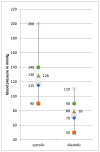Cardiovascular Risk Profiles and Pre-Existing Health Conditions of Trekkers in the Solu-Khumbu Region, Nepal
- PMID: 36554269
- PMCID: PMC9779219
- DOI: 10.3390/ijerph192416388
Cardiovascular Risk Profiles and Pre-Existing Health Conditions of Trekkers in the Solu-Khumbu Region, Nepal
Abstract
Background: High-altitude tourist trekking continues to grow in popularity on the Everest Trek in Nepal. We examined which pre-existing cardiovascular and health conditions these global trekkers had and what health issues they encountered during the trek, be it exacerbations of pre-existing conditions, or new acute ones.
Method: Trekkers (n = 350) were recruited from guesthouses along the Everest Trek, mostly at Tengboche (3860 m). After completing a questionnaire on their health and travel preparation, they underwent a basic physical examination with an interview.
Results: Almost half (45%) had pre-existing conditions, mostly orthopaedic and cardiovascular diseases. The average age was 42.7 years (range 18-76). The average BMI was 23.4 kg/m2, but 21% were overweight. A third were smokers (30%), and 86% had at least one major cardiovascular risk factor. A quarter (25%) were suffering from manifest acute mountain sickness (AMS), and 72% had at least one symptom of AMS. Adequate pre-travel examination, consultation, and sufficient personal preparation were rarely found. In some cases, a distinct cardiovascular risk profile was assessed. Hypertensive patients showed moderately elevated blood pressure, and cholesterol levels were favourable in most cases. No cardiovascular emergencies were found, which was fortunate as timely, sufficient care was not available during the trek.
Conclusion: The results of earlier studies in the Annapurna region should be revalidated. Every trekker to the Himalayas should consult a physician prior to departure, ideally a travel medicine specialist. Preventative measures and education on AMS warrant special attention. Travellers with heart disease or with a pronounced cardiovascular risk profile should be presented to an internal medicine professional. Travel plans must be adjusted individually, especially with respect to adequate acclimatisation time and no physical overloading. With these and other precautions, trekking at high altitudes is generally safe and possible, even with significant pre-existing health conditions. Trekking can lead to invaluable personal experiences. Since organized groups are limited in their flexibility to change their itinerary, individual trekking or guided tours in small groups should be preferred.
Keywords: acute mountain sickness; arrhythmia; cardiovascular risk factors; coronary heart disease; high altitude; trekking.
Conflict of interest statement
The authors declare no conflict of interest.
Figures
References
-
- World Health Organization . Global Status Report on Noncommunicable Diseases 2010. WHO—World Health Organization; Geneva, Switzerland: 2010. p. 176.
-
- World Health Organization . Global Status Report on Noncommunicable Diseases 2014. WHO—World Health Organization; Geneva, Switzerland: 2014. p. 302.
-
- Beedie P., Hudson S. Emergence of mountain-based adventure tourism. Ann. Tour. Res. 2005;30:635–643. doi: 10.1016/S0160-7383(03)00043-4. - DOI
-
- Kupper T. Ph.D. Thesis. RWTH Aachen Technical University; Aachen, Germany: 2006. Workload and Professional Requirements for Alpine Rescue.
Publication types
MeSH terms
LinkOut - more resources
Full Text Sources
Medical





